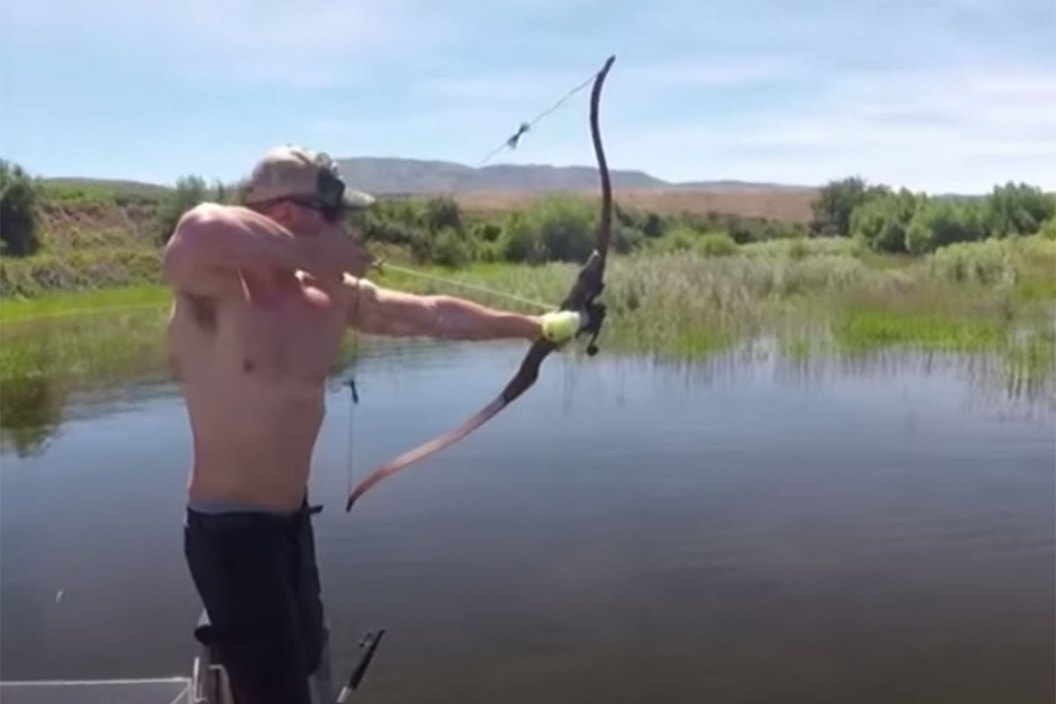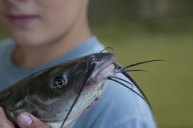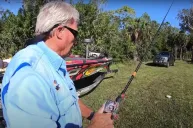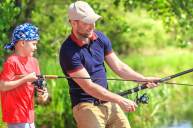Here are some tips and strategies for those new to bowfishing.
Everyone and anyone who has watched someone else draw back their bow and put a bullseye on a big fish has decidedly said to themselves, "I can do that."
And the honest answer is: yes you can, with a little experience and some easy-to-get gear.
It's not as easy as simply picking up a bow, aiming, and drilling a nice fish with an arrow, but it takes practice to complete the task along with some perseverance. For those that have already gone bowhunting or just like to target shoot, you have a head start. But for those that have never aimed into the water at a fish, seasoned vets will attest: it's not as easy as it looks!
This fishing technique has fast become a terrific hobby for thousands of outdoor lovers and it doesn't take a whole lot to get started. Bowfishing isn't just for archery enthusiasts or big game bowhunters, but rather anyone who feels that they would like to shoot a bow and go fishing at the same time. There may be local legalities to navigate, but for the most part, bowfishing is allowed nationwide.
Since bowfishing certainly started when some enterprising archery enthusiast took a shot at a fish, it stands to reason that as soon as they hit one, they immediately lost a good arrow, never to be seen again. It was then that they realized that some type of reel and line assembly was needed to complete the kit, and modern bowfishing was born.
It's become common to aim for invasive fish like grass carp, and the shooting opportunities that present themselves can teach you a lot. Alligator gar and tilapia are other species that can be fun to bowfish for.
Here are the three most common questions that beginners ask.
Can Any Bow Be Used for Bowfishing?
Many compound bows built specifically designed for bowfishing don't use require a D Loop or a release, as the draw weight is light enough for you to shoot with just your fingers. These bows are also built with a consistent draw weight, much like a recurve bow, for ease of shooting. The fancy user adjustments common to hunting bows these days just aren't really needed.
Any bow, whether it is a compound or a traditional recurve, can serve as a bowfishing bow. While it's possible to convert your hunting bow to a bowfishing rig, it's probably best to use a bow dedicated to bowfishing.
One piece of gear that is a must for any bowfishing rig is a reel. Most avid anglers will be familiar with the bowfishing reels that look and act like a spincast reel (the kind you or your kids probably learned to conventional fish on), but some reels have graduated to a higher level of sophistication and are built to be mounted on a bow and can be really effective. We'll go deeper into the topic of reels in a later section.
Where Do You Aim When Bowfishing?
A bowfisherman should try to hit the fish at its thickest part along the body, so the arrow does the most damage and stops the fish. But, as you've probably guessed, you can't aim directly at the part of the fish you intend on hitting.
Light refraction in the water, even in clear water, distorts the angler's eyesight, meaning an arrow aimed below the target has a better chance of striking where intended. The deeper the fish, the lower you should aim.
A good rule is to aim 3-4 inches lower than your target for every foot of depth you feel that the fish is in.
What's the Best Bow for Bowfishing?
Short of providing any direct recommendations, let's just say that if you ask 10 different people about the best bow for bowfishing, you will get 10 different answers. Prices can vary, and as it is with most outdoor gear, you get what you pay for. Beginners would benefit from saving costs and opting for entry level, lower priced bows while more experienced bowfishermen and women can feel confident that higher-end equipment can give them an advantage.
One factor worth remembering for many beginners is that the ideal draw weight for bowfishing is generally around 30-40 pounds. This is far less than the stronger draw weights usually associated with hunting bows since it doesn't take nearly as much to kill a fish as it does a deer.
We'll zoom in a little more on gear down below.
Bowfishing Locations
As with any legal fishing, no matter where you go bowfishing, you will need a recreational or sport fishing license. Every state has its own fish and game laws and you are responsible for familiarizing yourself with and making sure that you are legally licensed.
Not only that, but many common species of game fish are off-limits to bowfishermen. It's also worth it to point out that many areas that are considered urban may not allow bowfishing.
From there your options are likely still wide-ranging. In most place, you can bowfish from a boat or from shore, in a lake, reservoir, river, or stream. Ideally it's a place with clear enough water to spot fish targets, and enough room and access to cover a good amount of space. A bowfishing shot often scares surrounding fish from the area, meaning it's best to be on the move. Even the shallow saltwater flats, estuaries, and bays of the U.S. have areas that can be productively bowfished.
Bowfishing Gear
Next to bowhunting for big game, a bowfishing kit isn't as complex. There are a few items that are specialized for bowfishing, but you won't need to spend your entire paycheck to get a decent system for your own. The most important gear will be the bow, arrows, and reel. There are some bowfishing-specific lines that you may see out there, but many basic fishing lines will work just as well.
A recurve or compound bow will serve you well for bowfishing, and even though there are upsides and downsides to each type, it really just comes down to personal preference. Recurves are lighter and more simple mechanically, while compound bows are more powerful and precise.
There are essentially three kinds of bowfishing reels: the hand reel, bottle reel, and the spin casting reel. If you look long enough you will see all kinds of homemade reel systems people have come up with for bowfishing, but these three seem to be the best and most common.
The hand reel is probably the simplest line retriever and goes well with either type of bow. The downside is that you will need to use heavier lines and your hands to reel in fish or missed shots. This equates to a little more time, but the hand reel is simple to use, it's virtually unbreakable, and it's the most affordable type of reel.
The bottle reel is the most popular style because of its reliability and ease of use. The main factor is because it has a handle for reeling in the line. Bottle reels are better when used with heavier line, but that can sometimes reduce accuracy.
The spincast fishing reel is something of a top of the line system for bowfishing, even though they will cost you a little more. It works quite well with multiple line sizes, and particularly smaller diameter lines that provide the most accuracy.
Bowfishing arrows come in fiberglass, carbon, and hybrid styles. If you end up targeting larger fish, the more expensive carbon arrows are probably the best choice. Most fish arrow points include barbs.
Beginning bowfishers need to be aware that there are risks to bowfishing. A tangled line that gathers around an arrow could cause a shot to snap back and injure the fisherman.
A safety slide is a simple device that moves down the shaft of your arrow, bringing your line to the front, thus preventing any tangles. It is recommended that all bowfishermen use one.
Bowfishing 101
The three cardinal rules for bowfishing are: move slowly, avoid casting a shadow, and don't create movement on the water. The fish you are targeting are going to be in clear, shallow water, which means that they can see you before you see them.
For wading or fishing from shore, try not to knock any low-lying branches when getting into shooting position or make any sudden movements over the target.
As with ay fishing the best times are first thing in the morning and at last light. However, night bowfishing is growing in popularity, mainly due to its effectiveness. Boats rigged with specialized, moveable lights that can scan the night waters along with fishermen at the ready in the bow can have great success shooting fish well after dark, and have a boatload of fun doing it.
Bowfishing Basics
As with any of our beloved outdoor activities, there can be a lot of fun, but also a bit of risk as well. If you've gone fishing long enough, then you have probably gotten a hook stuck somewhere on your body. We all know enough to beware of the business end of a fishing lure.
The same goes with bowfishing; any bow is potentially dangerous and should be used only after plenty of practice, particularly with someone who is a veteran of archery. It should go without saying, but never draw and aim a bow towards anything you don't intend on destroying.
After the safety concerns are covered, there is virtually no end to the amount of fun you can have from the shore of a pond or the bow of a boat. Plus, there may be no better way to put on a great fish dinner than one where you can shish kebab the fish before you cook it!
Looking for a little more or even hot lunch for your hunting blind? Follow my webpage, or on Facebook and YouTube.
NEXT: THE 15 BEST FISHING HATS OF 2021: BUCKET, NET HATS & MORE
WATCH




